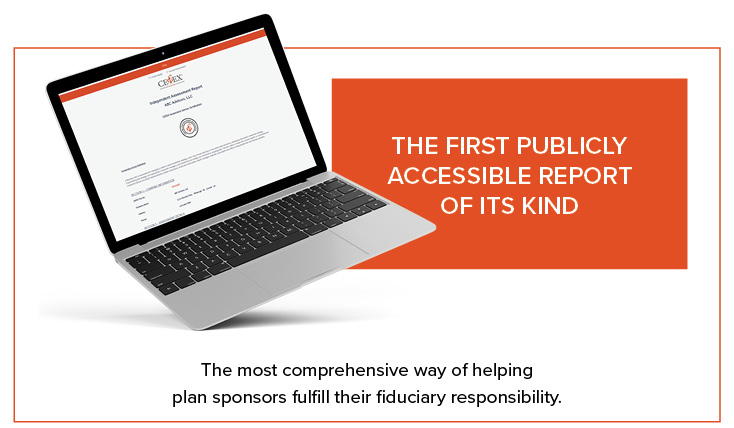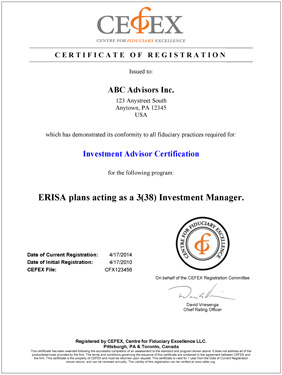Retirement Plans
Investment Stewards of retirement plans (e.g. investment committee members, trustees) have a responsibility to monitor the advisors they have hired. CEFEX has the expertise to assist in this task.
In other industries, product manufacturers mandate their suppliers to achieve ISO quality management system certification in order to ensure the highest level of quality assurance in their product.
Isn't this what retirement plans should expect? Many retirement plans are now mandating the CEFEX certification of advisory firms.
Request for Proposal Template for use by Plan Sponsors
CEFEX and fi360 have developed a standard Request for Proposal (RFP) template, which can be used by Investment Stewards of 401(k) plans to select their advisory firms. CEFEX-certified advisory firms are very well prepared to respond to this RFP because many of the requirements have already been addressed in the CEFEX assessment.
This RFP is suitable for distributing to plans, as they have the responsibility to prudently select their investment advisor(s).
Download the template here.
CEFEX Advisors help Stewards Meet Regulatory Requirements
In the U.S. the Employee Retirement and Income Security Act of 1974 (ERISA), the Uniform Prudent Investor Act (UPIA), the Uniform Prudent Management of Institutional Funds Act (UPMIFA) and the Uniform Management of Public Employee Retirement Systems Act (UMPERSA) identify the responsibilities of retirement plan trustees (Investment Stewards). For example:
-
Investment Stewards must monitor investment options with periodic reports comparing investment performance to appropriate indexes, peer groups and investment policy objectives. (Per ERISA §3(38); §402(c)(3); §404(a); §405(c)(2)(A)(iii) and per UPIA §2(a); §2(c); §9(a) and per UPMIFA §3(b); §3 (e); §5(a) and per UMPERSA §6(a); §6(b)(1-3); §6 Comments; §8(b))
The CEFEX certification of an Investment Advisory firm verifies the existence of due diligence in selecting investment options, thereby forming an excellent basis for the oversight by a Steward. Through the selection of a certified firm, the Investment Steward effectively delegates this highly specialized oversight task to the CEFEX Analyst, who is an investment expert.
-
Investment Stewards must apply a reasonable due diligence process in selecting service providers in a manner consistent with obligations of care. (Per ERISA §402(a)(1); §402(b)(2); §404(a)(1)(B); §405(c); §406(a); §408(b)(2) and per UPIA §2(a); §2(c); §2(f); §7 and Comments; §9(a)(1), (2) and (3) and per UPMIFA §3(b); §3(c); §3(a); §5(a) and per UMPERSA §6(a); §6(b)(1) and (2); §7; §8(a)(1))
When a Steward selects a CEFEX-certified advisory firm, the Steward has effectively applied a due diligence process since the CEFEX firm has been rigorously assessed to documented diligence parameters. Fundamental due diligence screens for governance, and fiduciary practice, allow the Steward to focus on specific investment strategies and other issues, such as participant retirement readiness.
-
Investment Stewards must periodically review qualitative and/or organizational changes of investment decision-makers. (Per ERISA §3(38); §402(c)(3); §404(a)(1)(b) and per UPIA §2(a); §7; §9(a) and per UPMIFA §3(b); §3(c); §5(a) and per UMPERSA §6(a) and (b)(1-3); §7(5))
A CEFEX-certified firm is assessed on an annual basis, when both qualitative and/or organizational changes are reviewed to determine whether or not fiduciary practices are affected. The CEFEX-certified firm is obligated to report changes to its clients, and this is verified in the assessment process.
-
Investment Stewards must conduct periodic reviews to ensure that investment-related fees, compensation and expenses are fair and rreasonable for the services provided. (Per ERISA §3(14)(B); §404(a)(1)(A),(B) and (D); §406(a); §408(b)(2) and per UPIA §2(a); §7 and Comments; §9 Comments and per UPMIFA §3(a)(b) and (c); §5(a) and (c)(1) and per UMPERSA §6(b)(2) and (3); §7(2) and (5); §7 Comments.)
Investment portfolios of CEFEX Investment Advisors are annually benchmarked against peer groups using the fi360 Investment Analyzer. The CEFEX Analyst uses this tool to identify watch-listed investment options, including a screen for fees. Thresholds for watch-lists are established and the Advisor must explain significant deviations.
-
Investment Stewards must require that agreements with service providers be in writing and consistent with fiduciary standards of care. (Per ERISA §3(14)(B); §3(38)(C); §402(c)(2); §403(a)(2); §404(a)(1); §408(b)(2) and per UPIA §2(a); §5; §7; §9(a)(2) and per UPMIFA §3(b); §3(c); §5(a) and per UMPERSA §5(a)(2); §6(b)(2); §7)
The CEFEX assessment includes a detailed review of the Advisory firm’s Service Agreement to ensure compliance with regulation, specifically § 408(b)(2) and to ensure it is used for all clients. Since the certification is renewed annually, this periodic review helps the Investment Steward fulfill this obligation as agreements change over time.
Introducing the Independent Assessment Report
With this CEFEX exclusive report, plan sponsors can now easily document their advisor selection with confidence. The IAR provides a summary of CEFEX’s rigorous annual assessment including the methodology, the date and the people involved.
Learn more about the Independent Assessment Report

The 3(38) Investment Manager role
Often, retirement plans elect to seek general safe harbor protection (insulation from certain liabilities associated with investment decisions) by delegating discretionary investment authority to an ERISA Section 3(38) investment manager.
CEFEX certified investment advisory firms that offer this safe harbor, as indicated in their scope of CEFEX certification, have been assessed on all of the associated ERISA requirements.

